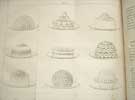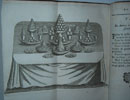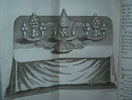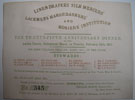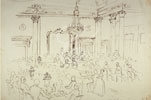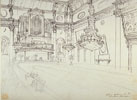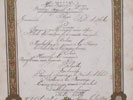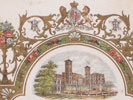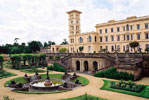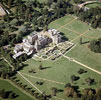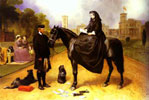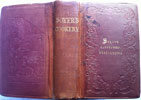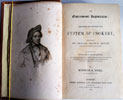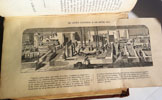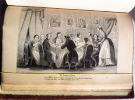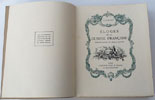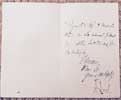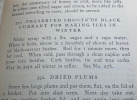The Big Fat Duck Cookbook
Heston Blumenthal BLOOMSBURY
FIRST EDITION. 2008. Large thick folio. 340x295mm. Paste-down and end-paper marbled. [1] 1p with Egg device and with his quite unique signature and 2 signed copies of 'Table d' Hote' menus -- See jpegs # 5 below. Frontis & Title page all one image. 4p Artwork. 8-11 Forward by Harold McGee. 2p Artwork. 2p History. [1] 17-516. 517-526 Index. 527-528 Acknowledgements. 529 Credits. [3] Rear end-paper, both sides and paste-down marbled. Fully bound in dark grey cloth with silver gilt devices on both covers and writing on the spine. All paper edges deep silver gilt. Slip case covered exactly the same as the book. With four brightly coloured page saving ribbons. Many full page colour photographs, artwork and illustrations throughout. Also comes with the original brown cardboard shipping box, which is covered in Fat Duck logo artwork. All in mint condition, as new.
- Heston Blumenthal of The Fat Duck Restaurant in Bray, Berkshire has been described as a culinary alchemist for his innovative style of cuisine. Besides being a highly accomplished chef a large part of his work entails researching the structures and molecular compounds of foods and dishes so to enable a greater understanding of taste and flavour. This original and scientific approach has teamed him with fellow chefs, scientists and psychologists throughout the world. His restaurant, The Fat Duck, opened in 1995 and was awarded its third Michelin star in January 2004. Other significant awards, among many, are; Gault Millau, 19/20 rating, January 2005; Chef of the Year Catering & Hotelkeeper Magazine, Catey Awards 2004; Good Food Guide accreditation 10/10, and best Restaurant in the UK, 2008; Second Best Restaurant In The World awarded by the Restaurant Magazines International Academy 50 Best Restaurants in the World Awards 2008; In July 2006 Blumenthal was awarded an Honorary Degree of Doctor of Science by The University of Reading for his dedicated research and commitment to the exploration of culinary science. Jay Rayner of The Observer. writes in 2008 about the The Big Fat Duck Cookbook --- "What Blumenthal has produced is, in truth, three books in one. At the front is the autobiography, beautifully and wittily illustrated by Dave McKean, who has reinvented the man as the fictional hero of his own narrative, all domed forehead, questing chin and razor-sharp glasses. That said, this is not some grimly narcissistic sleb memoir. If there is an anecdote here, it is because of the part it played in Blumenthal's development as a chef. Next comes the complete Fat Duck recipes, with the glossiest and filthiest of gastro-porn photography. (Who knew the whipping of a pink spiced pickling foam could look so, well, gynaecological?) These recipes are staggeringly long, involve fiendishly expensive pieces of equipment, are extraordinarily detailed and are probably, for the home cook, completely unmanageable, but that's to miss the point. As Blumenthal himself says: 'To change any part of these recipes so that they are more easily achievable would be to compromise - something this book does not do.' Even so, they are worth reading, partly because there are sub-recipes that are within reach (try the gratin of truffled macaroni), partly to appreciate the remarkable effort required to achieve the effect, and partly because it's fun to spot unlikely ingredients. Sure, there are references to substances from the industrial food world like the emulsifier lecithin and the protein 'glue' transglutaminase (oh, the things you can do to mackerel fillets with that). But there are also walk-on parts for frozen peas, mass-produced white bread and Marmite. Blumenthal is big on the flavours of our childhood, the easiest way to open the door to our memories, and he is not afraid to investigate the emotional punch of that nostalgia through his tasting menu. Finally there is the science stuff, a set of explanations so complete and detailed they've had to drop the type size to get it all in. And that, finally, is the point of this book: nothing has been left out; it is all here. It is true that a lot of enthusiastic home cooks will receive this as a gift this Christmas, pore over the pictures, read the text and never once cook from it. But a lot of professional chefs will also buy it, study and examine the text and recipes and let that shape their own cooking. Those wrong-headed, appetite-challenged killjoys who are suspicious of what Blumenthal does will regard this as an unfortunate development. As for me, I can only see it as a very good thing indeed". --- After all Jay Rayner has written this is a thoughfully constructed, original and very unusual but beautiful book, that won for Blumenthal, the Food Book of the Year Award at The Guild of Food Writers Awards, 2009. One assumes it will be a classic in future cookery book collections, if not already.


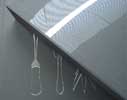


click on image to enlarge

Modern category
ref number:
11052 

